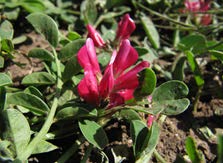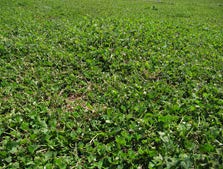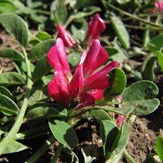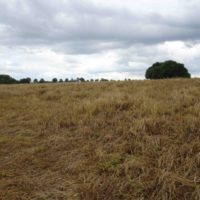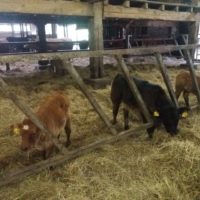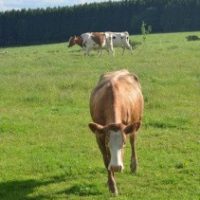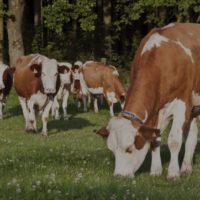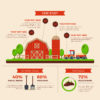Description
Background
The farm Santa Barbara has a long history. It belongs from over 50 years to the Porcu’s family. It occupies an area of 78 ha, located in Nurra lowland (Sassari district). The whole farm is potentially under irrigation but usually only 30% is irrigated. The farm is devoted to sheep breeding of the ‘Sarda’ breed: 600 ewes, 110 replacement lambs and 15 rams. Currently, Bastianino (51 years old) manages the farm with his son Roberto (21 years old). The main farm production was and still is sheep milk, which is delivered to a farmers’ cooperative producing mailnly Pecorino Romano PDO cheese. Starting from the early ‘80s, the market demand of Pecorino Romano underwent fluctuations and the market suffered from saturation. Consequently, sheep milk price started to drop. The farmer was forced to revise his farming system to stabilize and preserve his income. Prior to the milk price crisis, annual forage crops and winter cereals for grain production characterized the farming system, but the farmer bought on market hay and complements. Every year, the farmer carried out ploughing, fertilization and sowing, sustaining high costs for soil tillage and purchase of seeds and supplements. The farmer started to look for solutions to reduce costs and, possibly, to increase income. He decided to increase forage and hay self-sufficiency and to improve the quality of farm productions (milk). Thanks to the collaboration with consultants and technicians, he introduced pasture forage legumes and legume-based mixtures.
Detailed description
The farmer introduced several forage legumes to increase the flexibility of his forage system. He sowed innovative mixtures based on annual self-reseeding pasture legumes and winter cereals. Currently, the diet of dry or pregnant ewes in Porcu farm is based on fresh forage grazed in temporary legume-based grasslands and pastures, supplemented with hay and small amounts of concentrates (sugar beetroot pulps). The diet of lactating ewes is based on fresh forage grazed on temporary grasslands, supplemented with lucerne hay (twice a day) and concentrates (usually corn, pea and barley), according to the needs. Temporary (annual) grasslands are represented by different kinds of grass-legume mixtures (Lolium multiflorum or/and a local ecotype of Hordeum vulgare, Trifolium alexandrinum or T. incarnatum or T. resupinatum) and have a flexible use. Annual forage crops are grazed during winter and mowed for hay production in late spring. Forage legumes (white clover, sulla, subclovers and annual medics) are grazed. White clover is grown under irrigation during summer. Grazing is limited in time in the summer period but it is free for the remaining time. Sulla stands are sown within the first decade of October. Sulla stands are exclusively grazed. In the first growth period, grazing is allowed for 2 hours per day at most, and then it is increased to a maximum of 4 hours. With this management, sulla temporary grassland lasts 2 years. Annual self-reseeding pasture legumes (subclovers and medics) are sown in mixture with cereals. Cereals are present in the mixture composition to guarantee the herbage production starting from the year of establishment (winter). The farmer limits the grazing duration in the first period after sowing to obtain a good seed establishment. During winter and early spring, the stocking rate is increased at a high level. Afterwards, the farmers stops grazing in order to allow the self-reseeding of subterranean clovers. The legume-based pastures persist for 2-3 years. These temporary grasslands are not mowed. Lucerne is the forage crops that is cultivated in the farm for hay production. Usually, it is cultivated under irrigation in summer and the meadow lasts for 4-5 years. Farmers use occasional irrigations also to guarantee the autumn establishment of the temporary grasslands, e.g. sulla and annual self-reseeding legumes, and the summer growth of forage crops, e.g. white clover and lucerne.
Results
Currently, the farm is fully self-sufficient in forage, hay and straw production. Similarly, up to 90% of the supplements used in the farm are self-produced, except for sugar beetroot pulp, pea and barley that are purchased on the market. The wider use of forage legumes and the lower levels of inputs i.e. fertilizers, ploughing, seeds sensibly reduced the production cost of milk and milk quality was improved, too. The farmer obtained a higher yearly forage production, thanks to the extended forage growing season (especially in early autumn and late spring) and an improved forage quality, if compared to previous annual forage crops based on the monoculture of cereals.
Adoption criteria
Other farmers can successfully increase their forage self-sufficiency adopting the variety of temporary legume-based grasslands cultivated in the Porcu farm. In some cases, annual self-reseeding pasture species (subclovers and medics) in mixture with annual grasses and/or cereals could have a longer persistence than 3 years, especially if the appropriate grazing management and weed control are adopted, with positive effects on the farm cost reduction. The forage system adopted in the Porcu farm could be of great interest to farmers who carry out the out-of-season lambing in Mediterranean environments. In fact, for these farmers, the goal is to achieve regular sheep milk sales in the market throughout the year and higher milk remuneration during summer, but in normal conditions, they need to overcome the scarce availability of pastures during summer, at reasonable costs, at farm level.
Future prospects
The farmer would like to have the availability of new forage species to further extend seasonal forage availability in his farm. He thinks that a major role could be played by native forage species with improved forage production and drought tolerance. The farmer believes that use of the forage legumes could be boosted if more efficient and selective herbicides will be available to be used in the pure stands of temporary legumes, especially for Sulla. He would also appreciate the availability of devices for forage dry matter measurements to improve the management of pastures with rotational grazing.

